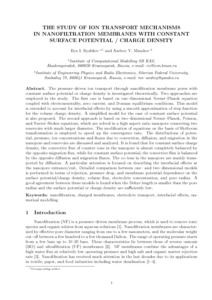Theoretical study of electrolyte transport in nanofiltration membranes with constant surface potential/charge density
Скачать файл:
URI (для ссылок/цитирований):
http://www.sciencedirect.com/science/article/pii/S037673881630415X?via%3Dihubhttps://elib.sfu-kras.ru/handle/2311/69803
Автор:
Рыжков, Илья Игоревич
Минаков, Андрей Викторович
Коллективный автор:
Институт космических и информационных технологий
Кафедра прикладной математики и компьютерной безопасности
Дата:
2016-12Журнал:
Journal of Membrane ScienceКвартиль журнала в Scopus:
Q1Квартиль журнала в Web of Science:
Q1Библиографическое описание:
Рыжков, Илья Игоревич. Theoretical study of electrolyte transport in nanofiltration membranes with constant surface potential/charge density [Текст] / Илья Игоревич Рыжков, Андрей Викторович Минаков // Journal of Membrane Science. — 2016. — Т. 520. — С. 515-528Аннотация:
The pressure-driven electrolyte transport through nanofiltration membrane pores with constant
surface potential or charge density is investigated theoretically.
Two approaches are employed in the study. The first one is based
on one-dimensional Nernst-Planck equation coupled with
electroneutrality, zero current, and Donnan equilibrium
conditions. This model is extended to account for interfacial
effects by using a smooth approximation of step function for the
volume charge density. The second approach is based on
two-dimensional Nernst-Planck, Poisson, and Navier-Stokes
equations, which are solved in a high aspect ratio nanopore
connecting two reservoirs with much larger diameter. The
modification of equations on the basis of Slotboom transformation
is employed to speed up the convergence rate. The distributions of
potential, pressure, ion concentrations and fluxes due to
convection, diffusion, and migration in the nanopore and
reservoirs are discussed and analyzed. It is found that for
constant surface charge density, the convective flux of
counter-ions in the nanopore is almost completely balanced by the
opposite migration flux, while for constant surface potential, the
convective flux is balanced by the opposite diffusion and
migration fluxes. The co-ions in the nanopore are mainly
transported by diffusion. A particular attention is focused on
describing the interfacial effects at the nanopore entrance/exit.
Detailed comparison between one- and two-dimensional models is
performed in terms of rejection, pressure drop, and membrane
potential dependence on the surface potential/charge density,
volume flux, ion concentration, and pore radius. A good agreement
between these models is found when the Debye length is smaller
than the pore radius and the surface potential or charge density
are sufficiently low.

